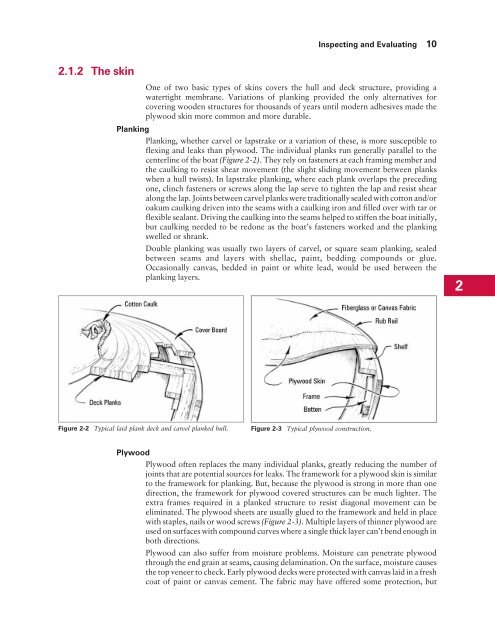Wooden Boat Restoration Repair - WEST SYSTEM Epoxy
Wooden Boat Restoration Repair - WEST SYSTEM Epoxy
Wooden Boat Restoration Repair - WEST SYSTEM Epoxy
You also want an ePaper? Increase the reach of your titles
YUMPU automatically turns print PDFs into web optimized ePapers that Google loves.
2.1.2 The skin<br />
One of two basic types of skins covers the hull and deck structure, providing a<br />
watertight membrane. Variations of planking provided the only alternatives for<br />
covering wooden structures for thousands of years until modern adhesives made the<br />
plywood skin more common and more durable.<br />
Planking<br />
Planking, whether carvel or lapstrake or a variation of these, is more susceptible to<br />
flexing and leaks than plywood. The individual planks run generally parallel to the<br />
centerline of the boat (Figure 2-2). They rely on fasteners at each framing member and<br />
the caulking to resist shear movement (the slight sliding movement between planks<br />
when a hull twists). In lapstrake planking, where each plank overlaps the preceding<br />
one, clinch fasteners or screws along the lap serve to tighten the lap and resist shear<br />
along the lap. Joints between carvel planks were traditionally sealed with cotton and/or<br />
oakum caulking driven into the seams with a caulking iron and filled over with tar or<br />
flexible sealant. Driving the caulking into the seams helped to stiffen the boat initially,<br />
but caulking needed to be redone as the boat’s fasteners worked and the planking<br />
swelled or shrank.<br />
Double planking was usually two layers of carvel, or square seam planking, sealed<br />
between seams and layers with shellac, paint, bedding compounds or glue.<br />
Occasionally canvas, bedded in paint or white lead, would be used between the<br />
planking layers.<br />
Figure 2-2 Typical laid plank deck and carvel planked hull. Figure 2-3 Typical plywood construction.<br />
Inspecting and Evaluating 10<br />
Plywood<br />
Plywood often replaces the many individual planks, greatly reducing the number of<br />
joints that are potential sources for leaks. The framework for a plywood skin is similar<br />
to the framework for planking. But, because the plywood is strong in more than one<br />
direction, the framework for plywood covered structures can be much lighter. The<br />
extra frames required in a planked structure to resist diagonal movement can be<br />
eliminated. The plywood sheets are usually glued to the framework and held in place<br />
with staples, nails or wood screws (Figure 2-3). Multiple layers of thinner plywood are<br />
used on surfaces with compound curves where a single thick layer can’t bend enough in<br />
both directions.<br />
Plywood can also suffer from moisture problems. Moisture can penetrate plywood<br />
through the end grain at seams, causing delamination. On the surface, moisture causes<br />
the top veneer to check. Early plywood decks were protected with canvas laid in a fresh<br />
coat of paint or canvas cement. The fabric may have offered some protection, but<br />
2
















